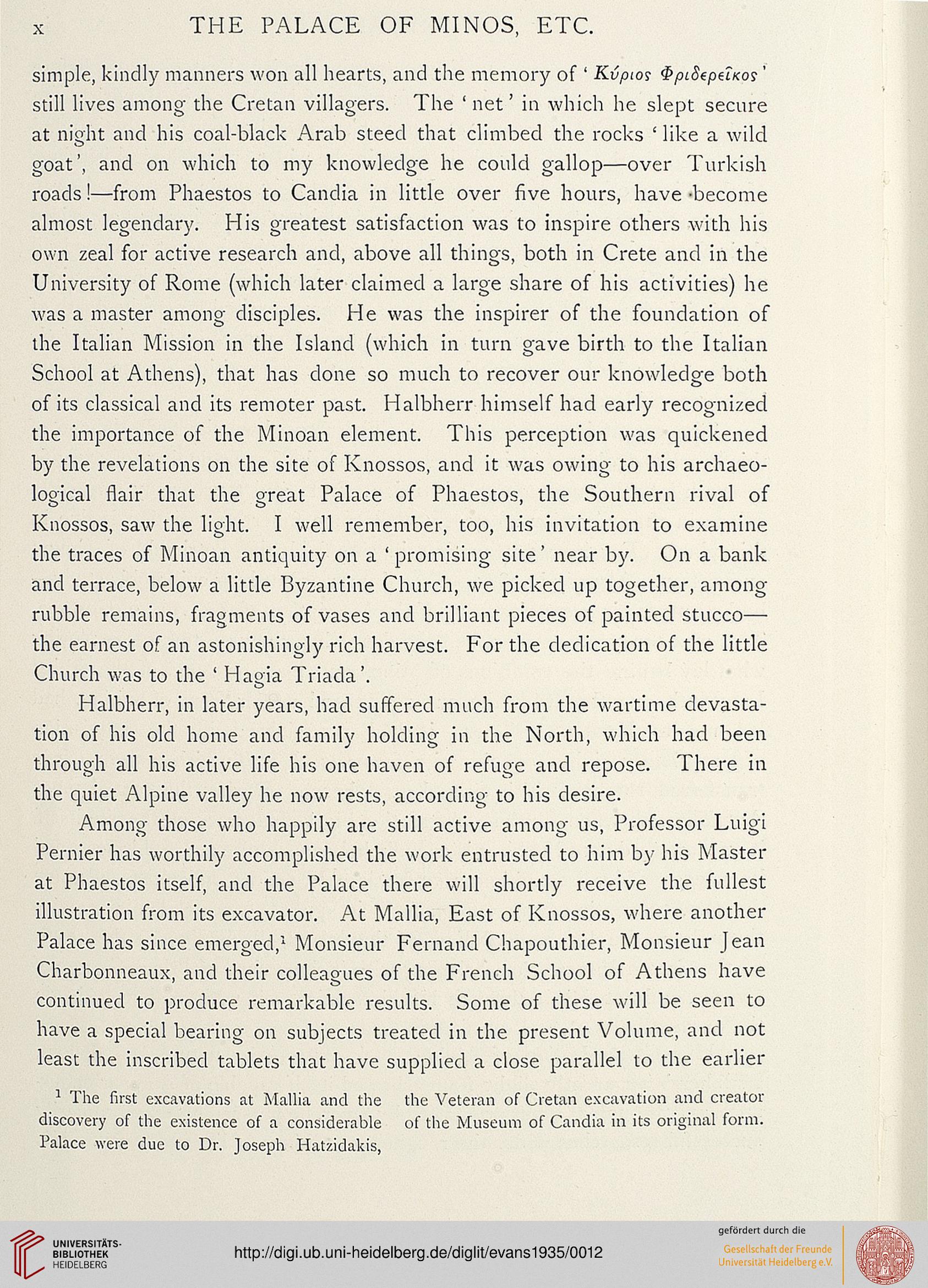x THE PALACE OF MINOS, ETC.
simple, kindly manners won all hearts, and the memory of ' Ktipios $pi8(pui<os'
still lives among the Cretan villagers. The ' net' in which he slept secure
at night and his coal-black Arab steed that climbed the rocks ' like a wild
goat', and on which to my knowledge he could gallop—over Turkish
roads!—from Phaestos to Candia in little over five hours, have -become
almost legendary. His greatest satisfaction was to inspire others with his
own zeal for active research and, above all things, both in Crete and in the
University of Rome (which later claimed a large share of his activities) he
was a master among disciples. He was the inspirer of the foundation of
the Italian Mission in the Island (which in turn gave birth to the Italian
School at Athens), that has clone so much to recover our knowledge both
of its classical and its remoter past. Halbherr himself had early recognized
the importance of the Minoan element. This perception was quickened
by the revelations on the site of Knossos, and it was owing to his archaeo-
logical flair that the great Palace of Phaestos, the Southern rival of
Knossos, saw the light. I well remember, too, his invitation to examine
the traces of Minoan antiquity on a ' promising site' near by. On a bank
and terrace, below a little Byzantine Church, we picked up together, among
rubble remains, fragments of vases and brilliant pieces of painted stucco—
the earnest of an astonishingly rich harvest. For the dedication of the little
Church was to the ' Hagia Triada'.
Halbherr, in later years, had suffered much from the wartime devasta-
tion of his old home and family holding in the North, which had been
through all his active life his one haven of refuge and repose. There in
the quiet Alpine valley he now rests, according to his desire.
Among those who happily are still active among us, Professor Luigi
Pernier has worthily accomplished the work entrusted to him by his Master
at Phaestos itself, and the Palace there will shortly receive the fullest
illustration from its excavator. At Mallia, East of Knossos, where another
Palace has since emerged,1 Monsieur Fernand Chapouthier, Monsieur Jean
Charbonneaux, and their colleagues of the French School of Athens have
continued to produce remarkable results. Some of these will be seen to
have a special hearing on subjects treated in the present Volume, and not
least the inscribed tablets that have supplied a close parallel to the earlier
1 The first excavations at Mallia and the the Veteran of Cretan excavation and creator
discovery of the existence of a considerable of the Museum of Candia in its original form.
Palace were due to Dr. Joseph Hatzidalcis,
simple, kindly manners won all hearts, and the memory of ' Ktipios $pi8(pui<os'
still lives among the Cretan villagers. The ' net' in which he slept secure
at night and his coal-black Arab steed that climbed the rocks ' like a wild
goat', and on which to my knowledge he could gallop—over Turkish
roads!—from Phaestos to Candia in little over five hours, have -become
almost legendary. His greatest satisfaction was to inspire others with his
own zeal for active research and, above all things, both in Crete and in the
University of Rome (which later claimed a large share of his activities) he
was a master among disciples. He was the inspirer of the foundation of
the Italian Mission in the Island (which in turn gave birth to the Italian
School at Athens), that has clone so much to recover our knowledge both
of its classical and its remoter past. Halbherr himself had early recognized
the importance of the Minoan element. This perception was quickened
by the revelations on the site of Knossos, and it was owing to his archaeo-
logical flair that the great Palace of Phaestos, the Southern rival of
Knossos, saw the light. I well remember, too, his invitation to examine
the traces of Minoan antiquity on a ' promising site' near by. On a bank
and terrace, below a little Byzantine Church, we picked up together, among
rubble remains, fragments of vases and brilliant pieces of painted stucco—
the earnest of an astonishingly rich harvest. For the dedication of the little
Church was to the ' Hagia Triada'.
Halbherr, in later years, had suffered much from the wartime devasta-
tion of his old home and family holding in the North, which had been
through all his active life his one haven of refuge and repose. There in
the quiet Alpine valley he now rests, according to his desire.
Among those who happily are still active among us, Professor Luigi
Pernier has worthily accomplished the work entrusted to him by his Master
at Phaestos itself, and the Palace there will shortly receive the fullest
illustration from its excavator. At Mallia, East of Knossos, where another
Palace has since emerged,1 Monsieur Fernand Chapouthier, Monsieur Jean
Charbonneaux, and their colleagues of the French School of Athens have
continued to produce remarkable results. Some of these will be seen to
have a special hearing on subjects treated in the present Volume, and not
least the inscribed tablets that have supplied a close parallel to the earlier
1 The first excavations at Mallia and the the Veteran of Cretan excavation and creator
discovery of the existence of a considerable of the Museum of Candia in its original form.
Palace were due to Dr. Joseph Hatzidalcis,




